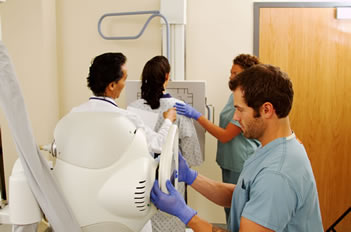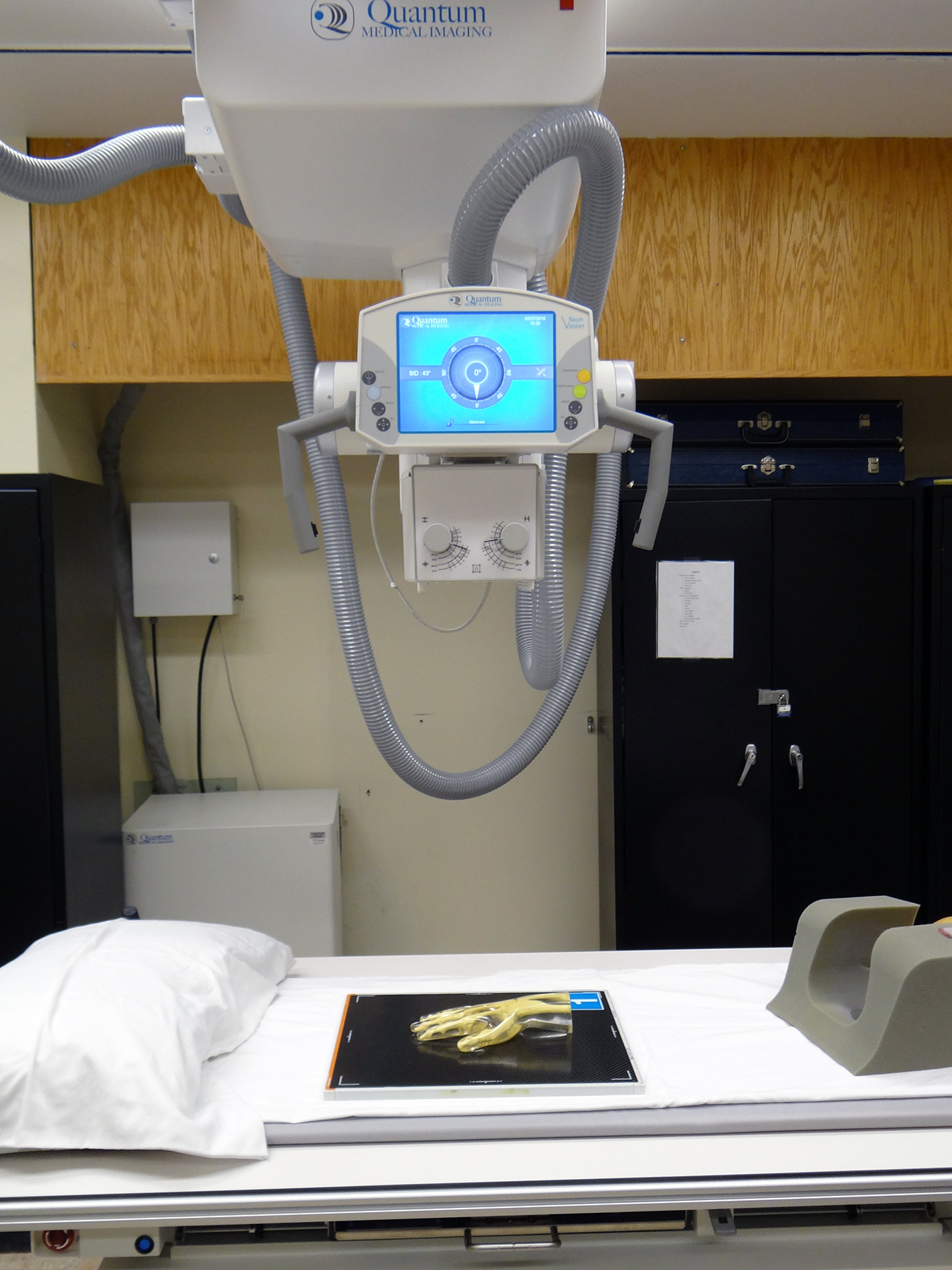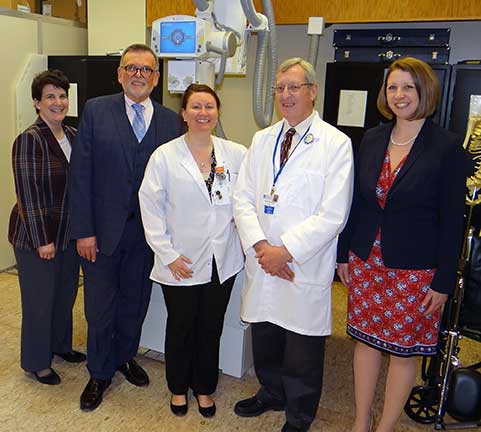Program Effectiveness
 While not everything can be explained with numbers, the following information is designed
to give the prospective student an idea of the effectiveness of the Radiologic Technology
Program by considering the Program Completion Rate, National Board Pass Rate, Job
Placement Rate, Graduate Survey and Employer Survey. The effectiveness statistics
are based on the most recent five years of available data in each area considered.
While not everything can be explained with numbers, the following information is designed
to give the prospective student an idea of the effectiveness of the Radiologic Technology
Program by considering the Program Completion Rate, National Board Pass Rate, Job
Placement Rate, Graduate Survey and Employer Survey. The effectiveness statistics
are based on the most recent five years of available data in each area considered.
The Radiologic Technology Program has set Benchmarks against which the Program evaluates its effectiveness. Benchmarks can be thought of as goals that the program strives to meet and hopefully exceed.
* Program effectiveness data can also be found on the JRCERT web-site: https://www.jrcert.org/
Annual Program Completion Rate
FIVE year Program Completion Rate Average = 83% (64/77)
Benchmark 65% Five year program completion rate (in three years or less)
Completion rate (beginning 2018) is calculated from after the first semester starting
in January and does not include students who withdrew of their own accord.
Benchmark 65% Five year program completion rate (in three years or less).
|
Year
|
Percentage of Class that completed Program in 3 years or less of starting. |
|---|---|
|
2024
|
100% (13/13)
|
|
2023
|
71.4% (10/14)
|
|
2022
|
81.2% (13/16)
|
|
2021
|
75% (12/16)
|
|
2020
|
88.8% (16/18)
|
National Boards Pass Rate
In order to get a license to practice Radiologic Technology in New York State, graduates of the Radiologic Technology Program are required to pass the national boards given by the American Registry of Radiologic Technologists (www.arrt.org). The following data represents the first attempt pass rate. Students have three attempts to pass the National Boards.
Five year success rate average on the examination in Radiography = 92.2% (59/64).
Benchmark 85% Five year pass rate on the A.R.R.T. Examination in Radiography.
| Year | Number of Examinees | First Attempt Pass Rate within Six Months of Graduation |
|---|---|---|
|
2024
|
13
|
100% (13/13)
|
|
2023
|
10
|
100% (10/10)
|
|
2022
|
13
|
85% (11/13)
|
|
2021
|
12
|
91.7% (11/12)
|
|
2020
|
15
|
87.5% (14/16)
|
Job Placement Rate
Five year average job placement in Radiography rate within 6 months of graduation = 100% (31/31).
Benchmark 75% Five year average job placement rate in radiography.
| Year | From Graduate Survey: Are you employed within 6 months of graduation? |
|---|---|
|
2024
|
100% (9/9)
|
|
2023
|
100% (8/8)
|
|
2022
|
100% (7/7)
|
|
2021
|
100% (4/4)
|
|
2020
|
100% (3/3)
|

Graduate Satisfaction Survey
Five year average graduate satisfaction rate within 6 months of graduation = 100% (31/31).
Benchmark 90% Five year average graduate satisfaction rate.
| Year | From the Graduate Survey: Overall, do you feel that your education in the Radiography Program prepared you to work as an effective member in the Radiography Department and as part of the health care team? |
|---|---|
|
2024
|
100% (9/9)
|
|
2023
|
100% (8/8)
|
|
2022
|
100% (7/7)
|
|
2021
|
100% (4/4)
|
|
2020
|
100% (3/3)
|
Employer Satisfaction Survey
Five year average employer satisfaction rate within 6 months of graduation = 100% (33/33).
Benchmark 90% Five year average employer satisfaction rate.
| Year | From the Employer Survey: Based upon performance of our graduates in your employ, is it likely that you would hire future graduates of SUNY-ORANGE? (Responses Likely PLUS Highly Likely) |
|---|---|
|
2024
|
100% (7/7)
|
|
2023
|
100% (9/9)
|
|
2022
|
100% (9/9)
|
|
2021
|
100% (4/4)
|
|
2020
|
100% (4/4)
|
New X-ray Equipment Enhances SUNY Orange Curriculum
4/12/2018
X-Ray Machine, Table, Image Receptor and Operating Software Contemporize Radiologic Technology Program
 MIDDLETOWN, N.Y. Collaborations between local businesses and organizations, energized
friends and donors, and SUNY Orange faculty and administrators allow the College to
enhance the student learning environment.
MIDDLETOWN, N.Y. Collaborations between local businesses and organizations, energized
friends and donors, and SUNY Orange faculty and administrators allow the College to
enhance the student learning environment.
A collaboration between the SUNY Orange Foundation and the College paved the way for a new x-ray machine, table, image receptor and operating software are now available to students in the SUNY Orange Radiologic Technology degree program.
This new equipment is comparable to what students encounter during their clinical experiences, meaning they will now be better-equipped as graduates for today s evolving healthcare field.
According to Nicole Rushing, chair of the Diagnostic Imaging Department, "The image receptor and computer function similar to a digital camera, but for X-ray. You take an X-ray, it's displayed in a few seconds on the screen and the system is ready for the next exposure. Prior to this, we were using an older plate reader (CR) and film in the darkroom for our experiments.
"Another feature is a very cutting-edge technology, which is a tablet that allows us to take X-rays with the digital receptor in either the new or old room without being wired into both. The new X-ray machine is ceiling mounted which allows us to move the equipment freely. We can now demonstrate trauma radiography and stretcher exams, which were very difficult in the past with the older equipment. Our new table not only allows for easy free-floating movement for positioning but also moves vertically. It features safety locks and a handle as well like many others in the hospital or outpatient sites.
 "All of this will allow us to teach in line with changes at the American Registry
of Radiologic Technologists, which specifies what will be on the National Boards.
For example, film was taken off the Registry with the focus being digital (computerized)
and direct systems. The PACS system allows us to incorporate another operating system
technologists use every day into our curriculum which better prepares students for
employment as well."
"All of this will allow us to teach in line with changes at the American Registry
of Radiologic Technologists, which specifies what will be on the National Boards.
For example, film was taken off the Registry with the focus being digital (computerized)
and direct systems. The PACS system allows us to incorporate another operating system
technologists use every day into our curriculum which better prepares students for
employment as well."
Caption: Shown with the new equipment is, from left: Dr. Kristine Young, president, SUNY Orange; Dr. Russell Hammond, executive director, SUNY Orange Foundation; Nicole Rushing, chair, SUNY Orange Diagnostic Imaging Department; Bob Misiak, former chair and longtime faculty member in the Diagnostic Imaging Department; and Dr. Erika Hackman, vice president of academic affairs, SUNY Orange.

